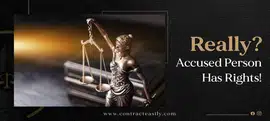
Section 144 of the Criminal Procedure Code
Section 144 of the Criminal Procedure Code
- Introduction
In the recent past, the application of Section 144 of the Criminal Procedure Code (CrPC) has been in extensive discussion. Various Indian state governments have applied Section 144 of the CrPC in the light of unruly protests where there are threats of violence. It was widely used in Jammu and Kashmir to maintain the law and order upon the abrogation of Article 370 of the Indian Constitution which used to grant Jammu and Kashmir a special status. It was also frequently used by many state administrations during widespread anti-CAA protests in the latter part of 2019. It was famously applied in big cities like Delhi, Bengaluru and led to the detention of hundreds of people including famous names like historian Ramchandra Guha, activist Yogendra Yadav, and communist leader Sitaram Yechury. In the light of this, it is important to know about the intricacies and the various legal aspects to the application of Section 144 of the CrPC. We will try to help you with just that and explain you the legal background behind the application of Section 144 of the CrPC.
- What exactly is the Section 144?
According to the written text in the CrPC, Section 144 gives powers to the district magistrate, a sub-divisional magistrate or any other executive magistrate who on the orders or directions of the particular state government can issue emergency written orders to prohibit the movement of people in order to maintain peace and stability. A magistrate can do so in the light of perceived danger or breakdown of public tranquility. The written order by the executive magistrate can prohibit the congregation of 4 or 5 or more persons at one place where the order is in existence.
The manner in which Section 144 orders are to be served are provided under section 134 of the CrPC. Section 134 states the orders made under Section 144 should be served to the particular person(s) if it is possible. Further, these orders have to notified by proclamation by the state government at such places where the public can easily stay informed about the order. However, Section 144 makes an exception and allows the serving of this order in an ex-parte manner if there is a grave emergency and threats of violence.
The section also provides the timeline for which such orders can stay in place. It states that ideally or in general state governments can enforce a Section 144 order for a period of two months and no longer than that. However, if the state government security apparatus apprehends on the basis of facts that the order needs to be extended to maintain peace, then there is an exception. If there is a threat of riot or violence that may lead to loss of human life, then state governments can extend the application of Section 144 to a period of 6 months.
- Does this section have any criticisms, if so, what are they?
Given the wordings of the provision it is clear that Section 144 is a power given to each state government to maintain the peace and prevent lawlessness in a particular area. On the face of it sounds like an essential power that allows state governments to prevent riots, unrest, or any other such acts of violence. However, it has been criticized a lot. The main criticism of the Section is that it is too broad in its wordings. It allows the magistrate the powers to issue order under the provision whenever he apprehends a danger, thus there might instances where the orders are applied unjustifiably.
The remedy provided to individuals after such an order is also not sufficient and it only allows an individual to file a revision application against the order to the same magistrate. This gets rejected often. The other remedy for concerned individuals who are against a Section 144 order lies with approaching the courts. A person could approach the High Courts with a writ petition under Article 226 of the Indian Constitution if fundamental rights are in question. However, the problem with this approach is it could take time and the rights of the individuals would already have been affected for a significant period of time.
- What do the courts opine about this section?
One of the earliest decisions on Section 144 of the CrPC was in the case of In Re: Ardeshir Phirozshaw vs Unknown (1939). The judge in the held that a magistrate is indeed allowed to restrict liberty under Section 144. However, the judge added a word of caution and ruled that such orders should be passed only keeping in mind the interests and safety of the public at large and should be not be passed at will. The judge also criticised an extended application of Section 144 for two months by stating that any such extended application of Section 144 has to be justified by proper facts and should be based on mere suspicions.
Post-independence, the significant ruling regarding Section 144 came in the judgment of Babulal Parate vs State of Maharashtra and Others (1961). A five-judge bench in the case refused to annul the law and confirmed that a person affected under this law did have the necessary remedies in place.
It was challenged again in the case of Ram Manohar Lohia And Ors. vs State of U.P. And Ors (1967), where the court again rejected its annulment. The court ruled that the state machinery could not function if there were no remedies available to them to prevent public disorder or threats of violence and unrest.
A seven judge-bench again upheld the constitutionality of the law in the case of Madhu Limaye vs Sub-Divisional Magistrate (1970). However, the judgment stated this power given to the magistrate is not ordinary but is judicial in nature. Thus, it would be subject to further judicial scrutiny.
Recently, in the case of Re-Ramlila Maidan Incident Dt vs Home Secretary and Ors (2012) the Supreme Court disapproved in strong words the application of Section 144 on a sleeping crowd in the Ramlila Maidan. It ruled that this provision should be applied only in cases of grave threats to the public peace, thus the threat should be grave and sudden to justify its applicability.
- Conclusion
The Section 144 of the CrPC has been one of the most widely discussed provisions of criminal law in the past year. In the light of growing protests, it is key for the governments to ensure that this provision is applied only in cases of imminent threats of violence and not as a mere tool of suppression of dissent. It will be remarkably interesting to see how the courts deal with this provision in the upcoming times if it continues to be applied extensively.







Posted In: Criminal Law
Posted By: abhishek.ag2000
Tags: Indian Law, law, legal, lawyers
1302